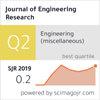Numerical investigation for enhancing HCCI combustion characteristics in DI-CI engine fueled with butanol/diesel blends
IF 0.9
4区 工程技术
Q3 ENGINEERING, MULTIDISCIPLINARY
引用次数: 0
Abstract
The fast depletion of fossil fuels and the hazardous emissions associated with the use of fossil fuels in IC engines is driving the research in the area of renewable fuels. Homogeneous charge combustion ignition (HCCI) is a new mode of engine combustion technology, used for reducing the emissions without compromising the engine performance. The combination of HCCI and alcohol/diesel blends has the potential to simultaneously address the twin problems of depletion of fossil fuels and engine emissions. Butanol is an attractive biofuel, which is produced from agriculture wastes such as sugar cane bagasses and corn stalk etc. This paper presents numerical and modeling analysis on the emission and performance characteristics of a direct injection- compression ignition (DI-CI) engine operated with butanol/diesel blends. Numerical analysis was carried out using CONVERGE CFD software. Response surface methodology (RSM) was used in developing the response models for three output parameters, viz., nitrogen oxides (NOx), soot emissions and indicated specific fuel consumption (ISFC), in terms of the four input parameters, viz., compression ratio (CR), start of injection (SOI), fuel injection pressure (FIP) and exhaust gas recirculation (EGR). Numerical experiments were conducted by varying these four input parameters, i.e., CR from 14 to 19, FIP from 200 to 280 bar, EGR from 0% to 30% and SOI from 17° to 29° CA bTDC, and with four butanol/diesel blends (0, 20%, 30% and 40% of butanol-by volume, designated as Bu00, Bu20, Bu30 and Bu40). The optimum combination of the input parameters for the four test fuels were found with the objective of minimizing the three output parameters (i.e., ISFC, soot and NOx) using desirability approach. The homogeneity of the air-fuel mixture was estimated using equivalence ratio distribution index, i.e., Target fuel distribution index (TFDI). From the numerical analysis, it was found that the TFDI improved for the optimized case by 20.5%, 21.5%, 24.4% and 27.2% for Bu00, Bu20, Bu30 and Bu40 respectively as compared to their respective baseline configuration.
丁醇/柴油混合燃料提高直喷发动机HCCI燃烧特性的数值研究
化石燃料的快速消耗和与内燃机中使用化石燃料相关的有害排放正在推动可再生燃料领域的研究。均质装药燃烧点火(HCCI)是一种新型的发动机燃烧技术,用于在不影响发动机性能的情况下减少排放。HCCI和酒精/柴油混合物的组合有可能同时解决化石燃料枯竭和发动机排放的双重问题。丁醇是从甘蔗、甘蔗渣、玉米秸秆等农业废弃物中提取的一种有吸引力的生物燃料。本文对使用丁醇/柴油混合燃料的直喷压缩点火发动机的排放特性和性能特性进行了数值分析和建模。采用CONVERGE CFD软件进行数值分析。采用响应面法(RSM),根据压缩比(CR)、启动喷射(SOI)、燃油喷射压力(FIP)和废气再循环(EGR)四个输入参数,建立了氮氧化物(NOx)、烟尘排放和指示油耗(ISFC)三个输出参数的响应模型。数值实验通过改变这四个输入参数进行,即CR从14到19,FIP从200到280 bar, EGR从0%到30%,SOI从17°到29°CA bTDC,并使用四种丁醇/柴油混合物(按体积计算丁醇为0、20%、30%和40%,分别称为Bu00、Bu20、Bu30和Bu40)。四种测试燃料的输入参数的最佳组合,目标是使用可取性方法最小化三个输出参数(即ISFC,烟灰和NOx)。采用等效比分布指数,即目标燃料分布指数(Target fuel distribution index, TFDI)来估计空燃混合气的均匀性。通过数值分析发现,优化后的Bu00、Bu20、Bu30和Bu40的TFDI分别比各自的基线配置提高了20.5%、21.5%、24.4%和27.2%。
本文章由计算机程序翻译,如有差异,请以英文原文为准。
求助全文
约1分钟内获得全文
求助全文
来源期刊

Journal of Engineering Research
ENGINEERING, MULTIDISCIPLINARY-
CiteScore
1.60
自引率
10.00%
发文量
181
审稿时长
20 weeks
期刊介绍:
Journal of Engineering Research (JER) is a international, peer reviewed journal which publishes full length original research papers, reviews, case studies related to all areas of Engineering such as: Civil, Mechanical, Industrial, Electrical, Computer, Chemical, Petroleum, Aerospace, Architectural, Biomedical, Coastal, Environmental, Marine & Ocean, Metallurgical & Materials, software, Surveying, Systems and Manufacturing Engineering. In particular, JER focuses on innovative approaches and methods that contribute to solving the environmental and manufacturing problems, which exist primarily in the Arabian Gulf region and the Middle East countries. Kuwait University used to publish the Journal "Kuwait Journal of Science and Engineering" (ISSN: 1024-8684), which included Science and Engineering articles since 1974. In 2011 the decision was taken to split KJSE into two independent Journals - "Journal of Engineering Research "(JER) and "Kuwait Journal of Science" (KJS).
 求助内容:
求助内容: 应助结果提醒方式:
应助结果提醒方式:


